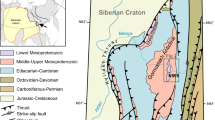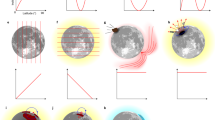Abstract
THE palæomagnetism of the dyke system radiating outward in a south-easterly direction from the large Pilansberg eruptive centre has been studied by Gough1. The basic parts of the dykes show a high magnetic consistency and, on the assumption of a geocentric dipole field, place the north magnetic pole in latitude 7½° N., longitude 47½° E. at the time of cooling. This time has always been inferred from surrounding systems, themselves not dated by radioactive methods.
This is a preview of subscription content, access via your institution
Access options
Subscribe to this journal
Receive 51 print issues and online access
$199.00 per year
only $3.90 per issue
Buy this article
- Purchase on Springer Link
- Instant access to full article PDF
Prices may be subject to local taxes which are calculated during checkout
Similar content being viewed by others
References
Gough, D. I., Mon. Not. Roy. Astro. Soc., 7, 1956 (1956).
Cooke, H. B. S., South African J. Sci., 50, 123 (1953).
Schreiner, G. D. L., Proc. Roy. Soc., A (in the press).
Author information
Authors and Affiliations
Rights and permissions
About this article
Cite this article
SCHREINER, G. Age of a Pilansberg Dyke of Palæomagnetic Significance. Nature 181, 1330–1331 (1958). https://doi.org/10.1038/1811330b0
Issue Date:
DOI: https://doi.org/10.1038/1811330b0
Comments
By submitting a comment you agree to abide by our Terms and Community Guidelines. If you find something abusive or that does not comply with our terms or guidelines please flag it as inappropriate.



